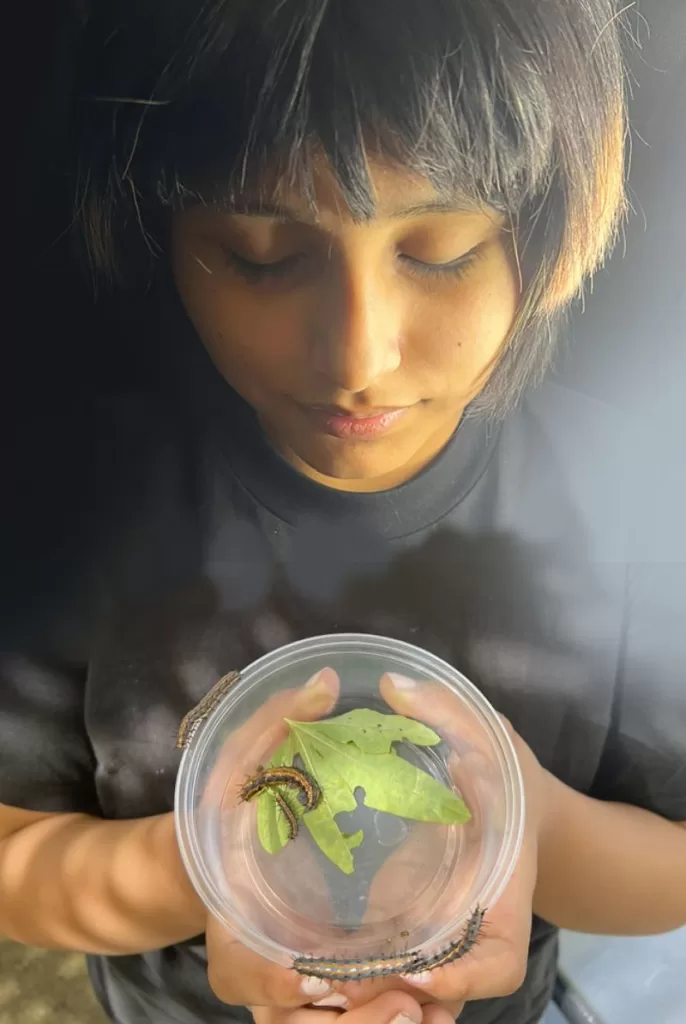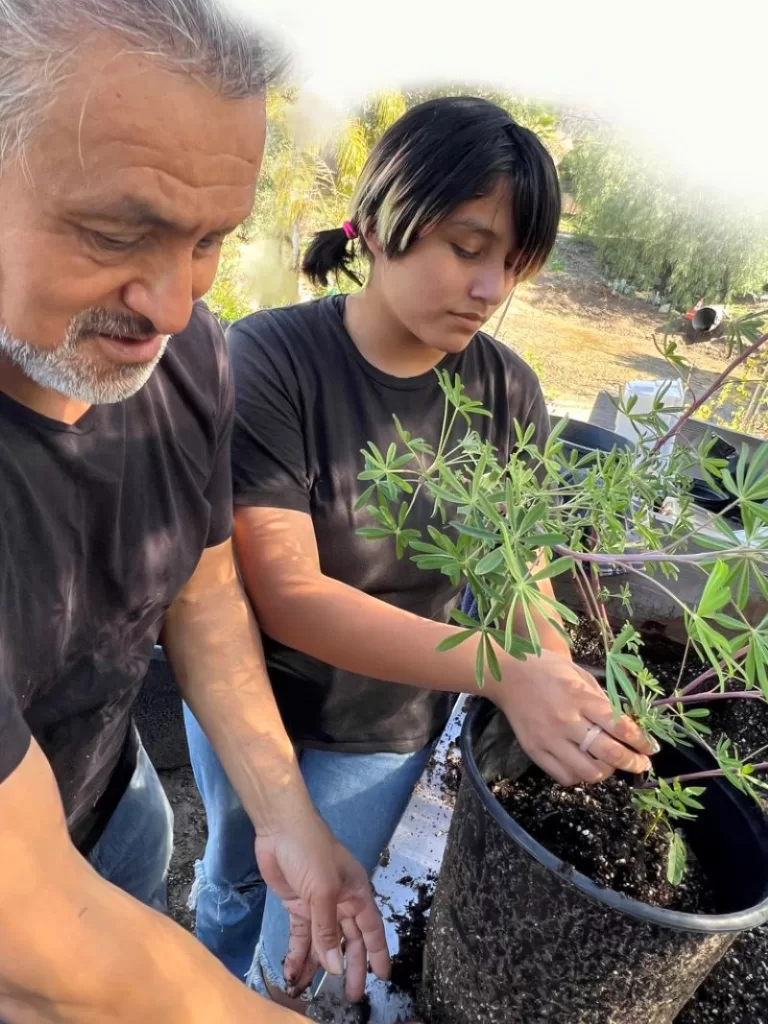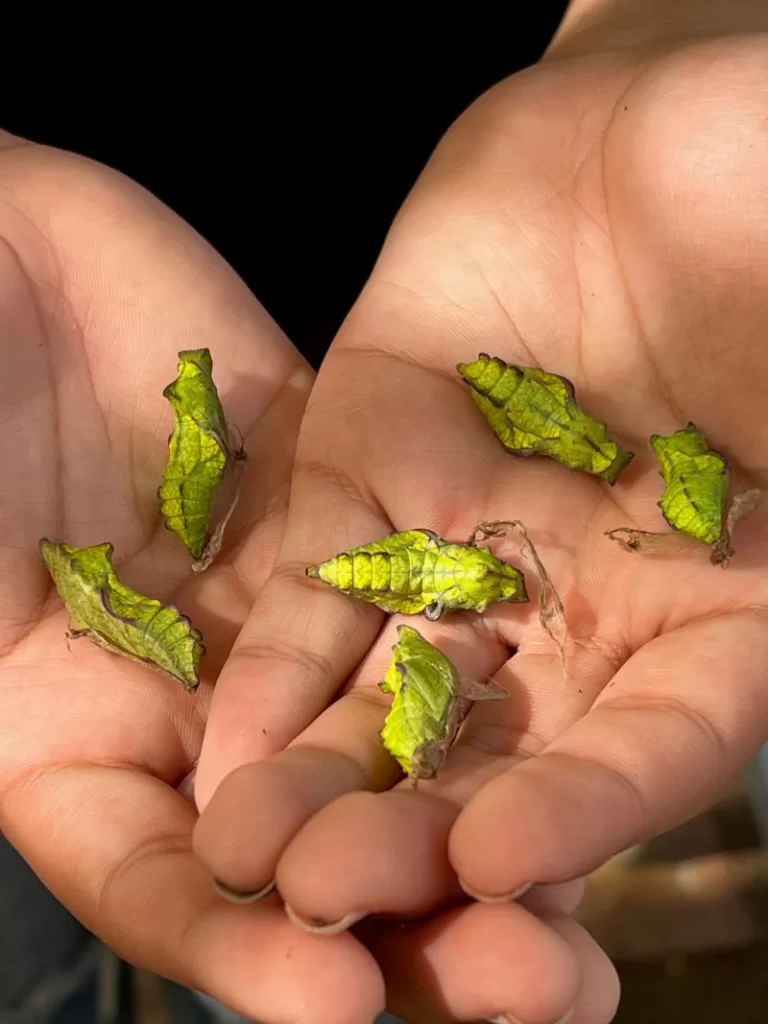
Young Topangan Coyolli Jimenez has been designated this year’s Butterfly Day Goodwill Ambassador. “Coyolli” is an Aztec name for a small ringing bell. It’s also the first name of the twelve-year-old daughter of Sergio Jimenez, the man in charge of butterflies at the Mountain Mermaid. Sergio’s wife, Yaotl, says Coyolli has been helping her dad raise butterflies since she was five years old.
Propagating live butterflies for the Fifth Annual Topanga Butterfly Day at the Mermaid on May 5, 2024 is job-one for Sergio and Coyolli. It seems only fitting that Coyolli be named this year’s Butterfly Day poster-child with her image gracing, quite literally, the posters and other announcements proclaiming the event.
Thirty-three years ago, when I bought the historic Mermaid—originally a country club built in 1930—it was a crumbling ruin ready to collapse. I hired Sergio to work on the restoration crew and, long-story-short, he made himself indispensable, has lived here ever-since, and has embraced butterflies to such a degree that he’s known as “The Butterfly Whisperer” here in Topanga.
Butterfly Day is a non-profit, pollinator-promoting nature festival that we host at the Mermaid every year. It’s a uniquely Topanga event for all ages, featuring a live-butterfly house, California native butterfly plants for sale, environmental organizations, a live music festival, a native Tongva ceremony, bee exhibit, a reptile and raptor show, face-painting, arts and crafts, food and drink, and more. 1500 people attended last year. This year, Sonic Butterfly, an inspired giant long-string harp that literally turns the entire Mermaid into a spectacular 100-foot-long musical instrument, will kick off the international Migration Tour of the monarch butterfly
Kids are instinctively drawn to butterflies. I know first-hand since I fell hopelessly in love with butterflies as a youngster growing up in Pacific Palisades in the 1950s. Back then, the Palisades was more like Topanga is today. There were wide open fields and running creeks, and a single mom-and-pop grocery store. My dad said he could have bought all of Potrero Canyon for $700.
I was awestruck by the colorful striped swallowtail caterpillars on the bright green anise plants. The plants grew wild everywhere and smelled like licorice. I collected the anise caterpillars and reared them in my bedroom. Like a mother bird, I brought them anise cuttings to eat, and watched in wonder as they morphed into chrysalises, and then into flying color-saturated creatures.
I’ve always had an artist’s eye and butterflies are the ultimate eye candy. It’s a familiar story told by many lepidopterists and entomologists (butterfly and insect scientists), that they got hooked on butterflies and insects when they were knee-high to a grasshopper. Suffice it to say that for me, raising butterflies for the Mermaid butterfly house, and hosting Butterfly Day, is a boyhood dream come true.
Growing butterflies in captivity is a challenging and protracted process, requiring much patience to follow the complex four-stage butterfly life-cycle from egg, to caterpillar, to chrysalis, and culminating in the winged adult. Rearing butterflies is an arcane endeavor practiced for fun by hobbyists, or for profit by butterfly breeders and butterfly farmers to provide specimens for live butterfly exhibits, scientific research, and for release at weddings, memorials, and such.
Sadly, many butterflies are propagated each year only to be euthanized, pinned, mounted, and sold to butterfly collectors, or as souvenirs, or trafficked illegally on the global black market for rare and endangered species.
Webster’s defines a butterfly house, flight-house, conservatory, or lepidopterarium as a facility which is specifically intended for the breeding and display of butterflies with an emphasis on education. The Mermaid Butterfly House is strictly for learning, inspiration and delight, with proceeds from Butterfly Day donated to various non-profit environmental organizations.
Without their specific host plants, the butterflies raised at the Mermaid would perish. Coyolli and her dad know well how fundamental plants are to butterfly farming. You need large amounts of the right kind of plants at the right time. Butterflies and plants evolved together over millions of years worldwide and are inextricably interdependent and specialized one to the other. Each species of butterfly has only one or a select few plant species that they are able to eat as caterpillars. Adult butterflies, however, are not as picky as the caterpillars, and will consume flower nectar from most any flowering plant, which are called their nectar plants.
Egg Stage: We have found it most effective and disease-free to begin rearing butterflies by collecting butterfly eggs in the wild. Knowledge of butterfly behavior and host plant relationships helps Sergio and Coyolli locate the tiny eggs. Looking for infinitesimally small butterfly eggs on big bushes and trees is not unlike trying to find the proverbial, “needle in a haystack”. Better to spot a female butterfly on the wing and try and follow her to see exactly where she lays her eggs.

Females can lay between 300 to 500 eggs over a two to five-week period and can sense their host plants from great distances. As they hone in on their target, they will flit and bob from plant to plant, touching and actually tasting them through sense organs in their feet to pinpoint the proper host plant. Males, on the other hand, are scouting for receptive females, and will exhibit different flying behaviors as they court and vigorously pursue prospective mates.
Once a female finds her host plant, she will usually deposit the eggs out of the view of predators on the undersides of the leaves, excreting a rapidly hardening glue. So, Coyolli and Sergio know to look mostly under the leaves for the eggs. Extracting the eggs one by one by hand would damage them, so Sergio has taught Coyolli to carefully snip off the leaves with the egg(s) still attached, then place them in a small container.
Caterpillar Stage: Caterpillars eat voraciously and will increase in size thousands of times during their lifecycle stage. Upon emerging from the egg, a caterpillar will first devour its eggshell and then begin eating the leaf onto which it was deposited. Sergio and Coyolli have to add more leaves to the rearing enclosures to keep up. Caterpillars produce prodigious amounts of caterpillar poop pellets, called “frass”. Captive breeding of any animal, from cats or caterpillars, can create an unnaturally crowded state prone to rapid disease transmission. So, the rearing enclosures need to be cleaned often and great care must be taken to sanitize hands and equipment. The caterpillar stage is the longest in the butterfly life-cycle. It can last from several weeks to several months. One could say butterfly farming is animal husbandry on a miniscule scale.
Sergio and Coyolli must be prepared with sufficient amounts of the various host plants for the many different butterfly species they are rearing. Fortunately, we have ample butterfly host plants in the Mermaid’s butterfly gardens where the leaves can be harvested for caterpillar food. Examples of these are oak, sycamore, passion vine, citrus, and milkweed.
Other host plants are raised from seed, or purchased. There’s a number of nursery areas at the Mermaid solely dedicated to growing, potting, and storing the hundreds of host plants required. Coyolli and Sergio also need to raise or buy hundreds of potted flowering nectar plants to feed the adult butterflies in the butterfly house.

Chrysalis Stage: Once a caterpillar is fully-grown, it enters the chrysalis stage and will spin filaments of silk to attach itself to the tops and sides of the rearing enclosures. A hard protective shell forms around it as if by magic. Inside the chrysalis, the caterpillar undergoes metamorphosis and transforms into an exquisitely folded adult butterfly package waiting to unfurl. The chrysalis stage typically lasts one to two weeks.
For a long time it was believed that the contents of a chrysalis was an amorphous liquid goo. More recent science shows that specific caterpillar body parts transmute inside the chrysalis into specific adult butterfly parts. For example, the caterpillar’s mandibles used for chewing will evolve into the adult butterfly’s proboscis, or feeding tube. How cool is that!
Adult Stage: Once metamorphosis is complete, the adult butterfly emerges from the chrysalis fully-formed and ready to soar, mate, and lay eggs. The length of this stage depends on the species of butterfly and can vary from several days to several months. When a butterfly emerges from a chrysalis, its wings are seriously wrinkled. The butterfly will hang wings down and slowly pump them full of fluids to straighten them out. The lifespan of most adult butterflies is two to three weeks, but it can vary greatly among different species.
We raise butterflies because we love being around them and to have live specimens for our educational tours of the butterfly house throughout the year and on Butterfly Day. I wish our butterfly house was a bigger habitat so the butterflies had more room to fly. In nature, only one or two percent of butterflies will make it from egg to adult. The Mermaid Butterfly House is designed to be a predator-proof environment against ants, wasps, lizards, frogs, rats, mice, possums, and racoons that all eat butterflies during one or more of butterfly life-stages. Butterfly-life may seem idyllic to us, but it’s a short and tough existence, fraught with danger!
Forty years ago there were few live live-butterfly exhibits worldwide. Since then, they have grown massively in popularity on every continent, spawning a big cottage industry in butterfly farming. Farming butterflies as a livelihood has lifted many families out of poverty in third-world countries and all around the world. Live-butterfly exhibitors usually purchase their butterflies from butterfly breeders and brokers, but our goal is to show butterflies that are homegrown in Topanga.
The goal for Butterfly Day 2024 is to raise ALL of our own butterflies. Sergio, Coyolli, Yaotl, and I have been working on it all year. We assembled a beautiful new butterfly propagation room with gleaming stainless steel tables, and new breeding enclosures. Sergio purchased a new microscope for detecting pathogens, and other butterfly-rearing paraphernalia. Butterflies are warm-weather creatures with a natural tendency to go dormant or migrate during the colder months, so they are much harder to raise this time of year. I can’t make promises for mother nature, but so far, it’s looking good!
It is an honor to be able to host Butterfly Day at the Mermaid again this year. My heartfelt thanks goes out to Dr. Alicia Land-Hill, Dr. Kent Hill, and Stephen Powers, co-founding members with me of the Butterfly Day Organizing Committee, to the extraordinary community of Topanga, to my ever-patient and supportive neighbors, to the fabulous Topanga Canyon Docents who manage the Butterfly House on Butterfly Day, to Theatricum Botanicum and Clare Brown for use of their parking facilities, and to all the wonderful volunteers. Thanks to Coyolli, for being our inspiration this year, and to the entire Jimenez family. All of you are the unsung, heavy-lifting heroes of Butterfly Day to whom I am eternally grateful. And, finally, thanks to all of the gorgeous butterflies that bring so much beauty, joy, and grace into our world.
By Bill Buerge





